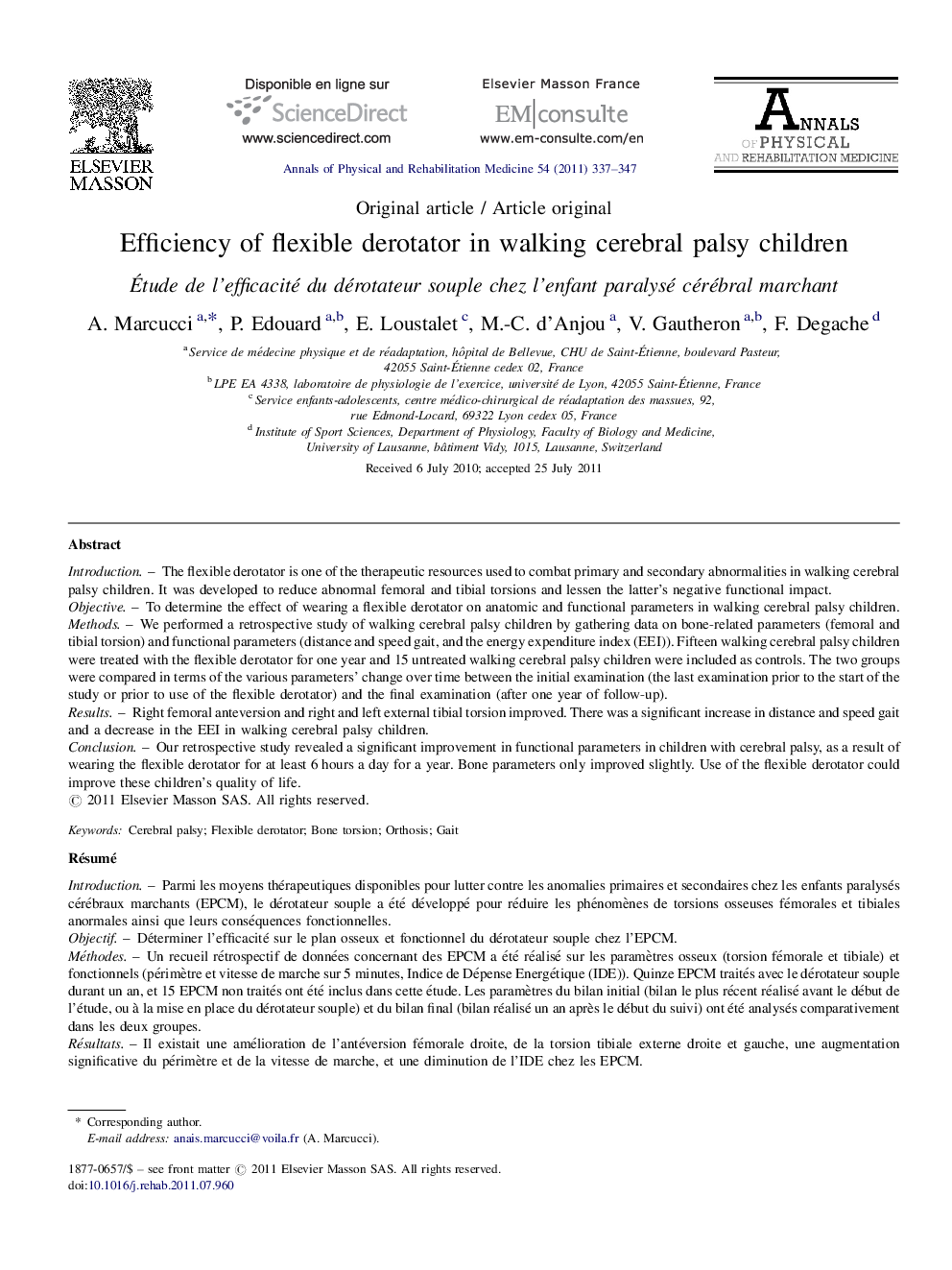| کد مقاله | کد نشریه | سال انتشار | مقاله انگلیسی | نسخه تمام متن |
|---|---|---|---|---|
| 4041239 | 1603335 | 2011 | 11 صفحه PDF | دانلود رایگان |

IntroductionThe flexible derotator is one of the therapeutic resources used to combat primary and secondary abnormalities in walking cerebral palsy children. It was developed to reduce abnormal femoral and tibial torsions and lessen the latter's negative functional impact.ObjectiveTo determine the effect of wearing a flexible derotator on anatomic and functional parameters in walking cerebral palsy children.MethodsWe performed a retrospective study of walking cerebral palsy children by gathering data on bone-related parameters (femoral and tibial torsion) and functional parameters (distance and speed gait, and the energy expenditure index (EEI)). Fifteen walking cerebral palsy children were treated with the flexible derotator for one year and 15 untreated walking cerebral palsy children were included as controls. The two groups were compared in terms of the various parameters’ change over time between the initial examination (the last examination prior to the start of the study or prior to use of the flexible derotator) and the final examination (after one year of follow-up).ResultsRight femoral anteversion and right and left external tibial torsion improved. There was a significant increase in distance and speed gait and a decrease in the EEI in walking cerebral palsy children.ConclusionOur retrospective study revealed a significant improvement in functional parameters in children with cerebral palsy, as a result of wearing the flexible derotator for at least 6 hours a day for a year. Bone parameters only improved slightly. Use of the flexible derotator could improve these children's quality of life.
RésuméIntroductionParmi les moyens thérapeutiques disponibles pour lutter contre les anomalies primaires et secondaires chez les enfants paralysés cérébraux marchants (EPCM), le dérotateur souple a été développé pour réduire les phénomènes de torsions osseuses fémorales et tibiales anormales ainsi que leurs conséquences fonctionnelles.ObjectifDéterminer l’efficacité sur le plan osseux et fonctionnel du dérotateur souple chez l’EPCM.MéthodesUn recueil rétrospectif de données concernant des EPCM a été réalisé sur les paramètres osseux (torsion fémorale et tibiale) et fonctionnels (périmètre et vitesse de marche sur 5 minutes, Indice de Dépense Energétique (IDE)). Quinze EPCM traités avec le dérotateur souple durant un an, et 15 EPCM non traités ont été inclus dans cette étude. Les paramètres du bilan initial (bilan le plus récent réalisé avant le début de l’étude, ou à la mise en place du dérotateur souple) et du bilan final (bilan réalisé un an après le début du suivi) ont été analysés comparativement dans les deux groupes.RésultatsIl existait une amélioration de l’antéversion fémorale droite, de la torsion tibiale externe droite et gauche, une augmentation significative du périmètre et de la vitesse de marche, et une diminution de l’IDE chez les EPCM.ConclusionCette étude rétrospective rapportait une amélioration significative des paramètres fonctionnels chez les enfants paralysés cérébraux ayant porté le dérotateur souple quotidiennement six heures par jour pendant un an, mais une faible amélioration des paramètres osseux. Cela pourrait ainsi améliorer la qualité de vie de l’enfant.
Journal: Annals of Physical and Rehabilitation Medicine - Volume 54, Issue 6, September 2011, Pages 337–347